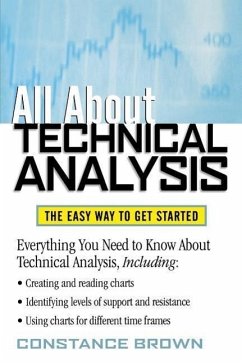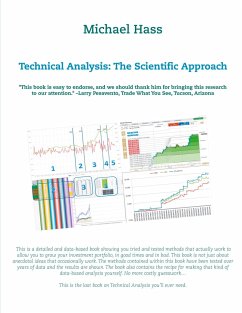- Broschiertes Buch
- Merkliste
- Auf die Merkliste
- Bewerten Bewerten
- Teilen
- Produkt teilen
- Produkterinnerung
- Produkterinnerung
"ALL ABOUT . . . SERIESAll AboutTECHNICAL ANALYSISWary of trusting their trading fortunes to chance, investors are increasingly turning to the proven tools of technical analysis to help them make better trading and investing decisions. "All About Technical Analysis explains what technical analysis is, why so many savvy investors rely on it to help forecast market movements, and how to successfully blend it into an overall investing program.
Andere Kunden interessierten sich auch für
![Technical Analysis Technical Analysis]() Charles D. KirkpatrickTechnical Analysis99,99 €
Charles D. KirkpatrickTechnical Analysis99,99 €![The Management of Technical Change The Management of Technical Change]() A. BoothThe Management of Technical Change81,99 €
A. BoothThe Management of Technical Change81,99 €![ANALYSIS OF TECHNICAL EFFICIENCY IN CASSAVA PRODUCTION ANALYSIS OF TECHNICAL EFFICIENCY IN CASSAVA PRODUCTION]() Kasim MelkaANALYSIS OF TECHNICAL EFFICIENCY IN CASSAVA PRODUCTION43,99 €
Kasim MelkaANALYSIS OF TECHNICAL EFFICIENCY IN CASSAVA PRODUCTION43,99 €![The Management of Technical Change The Management of Technical Change]() Alan BoothThe Management of Technical Change81,99 €
Alan BoothThe Management of Technical Change81,99 €![Technical Efficiency Analysis of Provincial Hospitals in Afghanistan Technical Efficiency Analysis of Provincial Hospitals in Afghanistan]() Mir Najmuudin HashimiTechnical Efficiency Analysis of Provincial Hospitals in Afghanistan39,99 €
Mir Najmuudin HashimiTechnical Efficiency Analysis of Provincial Hospitals in Afghanistan39,99 €![Analysis of Technical Efficiency of Small Holder Tef Producing Farmers Analysis of Technical Efficiency of Small Holder Tef Producing Farmers]() Kumadebis Tamiru GemechuAnalysis of Technical Efficiency of Small Holder Tef Producing Farmers28,99 €
Kumadebis Tamiru GemechuAnalysis of Technical Efficiency of Small Holder Tef Producing Farmers28,99 €![Technical Analysis: The Scientific Approach Technical Analysis: The Scientific Approach]() Michael HassTechnical Analysis: The Scientific Approach42,99 €
Michael HassTechnical Analysis: The Scientific Approach42,99 €-
-
-
"ALL ABOUT . . . SERIESAll AboutTECHNICAL ANALYSISWary of trusting their trading fortunes to chance, investors are increasingly turning to the proven tools of technical analysis to help them make better trading and investing decisions. "All About Technical Analysis explains what technical analysis is, why so many savvy investors rely on it to help forecast market movements, and how to successfully blend it into an overall investing program.
Hinweis: Dieser Artikel kann nur an eine deutsche Lieferadresse ausgeliefert werden.
Hinweis: Dieser Artikel kann nur an eine deutsche Lieferadresse ausgeliefert werden.
Produktdetails
- Produktdetails
- Verlag: McGraw Hill LLC
- Seitenzahl: 288
- Erscheinungstermin: 30. Dezember 2002
- Englisch
- Abmessung: 230mm x 152mm x 22mm
- Gewicht: 454g
- ISBN-13: 9780071385114
- ISBN-10: 0071385118
- Artikelnr.: 11120634
- Herstellerkennzeichnung
- Libri GmbH
- Europaallee 1
- 36244 Bad Hersfeld
- gpsr@libri.de
- Verlag: McGraw Hill LLC
- Seitenzahl: 288
- Erscheinungstermin: 30. Dezember 2002
- Englisch
- Abmessung: 230mm x 152mm x 22mm
- Gewicht: 454g
- ISBN-13: 9780071385114
- ISBN-10: 0071385118
- Artikelnr.: 11120634
- Herstellerkennzeichnung
- Libri GmbH
- Europaallee 1
- 36244 Bad Hersfeld
- gpsr@libri.de
Constance Brown, CMT (Chartered Market Technician), founded Aerodynamic Investments, Inc., after working for more than 15 years as an institutional trader in New York City. She continues to actively trade and advises numerous financial institutions and banks around the world.
Part One: What is Technical Analysis, and Who Can Benefit?
Chapter 1: Could Charts Have Called the Enron Collapse?
Chapter 2: What Is Technical Analysis and Who Uses It?
Chapter 3: Can Mutual Fund Investors Use Technical Analysis?
Part Two: How to Create Charts
Chapter 4: How to Get the Data into Your Computer
Chapter 5: Weekly, Monthly, and Intraday Time Intervals: How to Display the
Data
Chapter 6: How Asian Traders Prefer to Display Data
Chapter 7: Why the U.S. Dollar Dictates the Longevity of an American Equity
Bull Market
Chapter 8: Help! Short- and Long-Term Interest Rates Are Really Confusing
Money Market Securities or Short-Term Interest Rate Markets
Intermediate- and Long-Term Fixed Income Markets
Price-to-Yield Relationship
Yield to Maturity versus Realized Yield
Yield Curves
Chapter 9: Why a North American Needs International Market Data
Chapter 10: Wait a Minute! Isn't That Real Estate Data?
Part Three: How to Read the Data to Make a Decision
Chapter 11: A Big-Picture Summary of the Different Approaches within
Technical Analysis
Category One: Does the Method or Technique Depend on Pattern Recognition?
Category Two: Does the Method Focus on the Geometric Mathematical
Relationships within the Market's Price Data or Indicators?
Category Three: Does the Method Strive to Identify Behavioral Traits and
Study Extremes of Market Participants?
Category Four: Does the Method Strive to Detect Correlations between
Different Markets to Determine If One Market Is Providing a Leading Signal
for Another?
Chapter 12: Directional Patterns and Signals within the Data
Chapter 13: Why Are There Holes in My Data?
Chapter 14: Understanding Trends and Basic Market Geometry
Chapter 15: Using Market Geometry for Price Projections
Chapter 16: Ways to Detect Market Extremes Using Price, Breadth, and
Sentiment
Chapter 17: The Hottest Stock since Green Ketchup! How to "Listen" to the
Media with a Technical Mindset
Part Four: How to Handle Specific Problems
Chapter 18: Price Targets for Stocks Just Listed and Other Challenges
How Do You Calculate Support or Resistance for a Stock Just Listed with No
Historical Data?
How Do You Calculate Market Support When the Index Has Fallen below
Historic Price Lows?
How Do You Calculate a Price Objective When the Stock or Market Is Trading
above Historic Highs?
How the Internet Can Lead You to a Poor Market Decision
What Is the Global Industry Classification Standard and How Do You Use
Stock Sectors for Analysis?
Part Five: Lessons From Global Market Shock Waves
Chapter 19: Lessons from Global Market Shock Waves
The Americas Catch the Asian Flu in 1998
The "Dot Gones": Researching Opportunities after a Market Implodes
September 11, 2001
Part Six: Why Does Technical Analysis Work?
Chapter 20: What Do Seashells, Hurricanes, and the Dow Jones Industrial
Average All Have in Common?
Chapter 21: A Universal Higher Order and How All Things Are Indeed
Connected
Part Seven: Market Cycles and Long-Term Cycles of Importance
Chapter 22: Market Cycles and Long-Term Cycles of Importance
Part Eight: Putting it All Together with Risk Exposure in Mind
Chapter 23: A Broker Has Just Recommended that You Buy a Stock. What Do You
Do Next?
Chapter 24: The 27 Million Dollar Lunch
Appendix A: The Growth of Technical Analysis in Universities and Colleges
Technical Analysis Academic Programs
Coming Soon-Curriculum Under Development
Technical Analysis Organizations
Index
Chapter 1: Could Charts Have Called the Enron Collapse?
Chapter 2: What Is Technical Analysis and Who Uses It?
Chapter 3: Can Mutual Fund Investors Use Technical Analysis?
Part Two: How to Create Charts
Chapter 4: How to Get the Data into Your Computer
Chapter 5: Weekly, Monthly, and Intraday Time Intervals: How to Display the
Data
Chapter 6: How Asian Traders Prefer to Display Data
Chapter 7: Why the U.S. Dollar Dictates the Longevity of an American Equity
Bull Market
Chapter 8: Help! Short- and Long-Term Interest Rates Are Really Confusing
Money Market Securities or Short-Term Interest Rate Markets
Intermediate- and Long-Term Fixed Income Markets
Price-to-Yield Relationship
Yield to Maturity versus Realized Yield
Yield Curves
Chapter 9: Why a North American Needs International Market Data
Chapter 10: Wait a Minute! Isn't That Real Estate Data?
Part Three: How to Read the Data to Make a Decision
Chapter 11: A Big-Picture Summary of the Different Approaches within
Technical Analysis
Category One: Does the Method or Technique Depend on Pattern Recognition?
Category Two: Does the Method Focus on the Geometric Mathematical
Relationships within the Market's Price Data or Indicators?
Category Three: Does the Method Strive to Identify Behavioral Traits and
Study Extremes of Market Participants?
Category Four: Does the Method Strive to Detect Correlations between
Different Markets to Determine If One Market Is Providing a Leading Signal
for Another?
Chapter 12: Directional Patterns and Signals within the Data
Chapter 13: Why Are There Holes in My Data?
Chapter 14: Understanding Trends and Basic Market Geometry
Chapter 15: Using Market Geometry for Price Projections
Chapter 16: Ways to Detect Market Extremes Using Price, Breadth, and
Sentiment
Chapter 17: The Hottest Stock since Green Ketchup! How to "Listen" to the
Media with a Technical Mindset
Part Four: How to Handle Specific Problems
Chapter 18: Price Targets for Stocks Just Listed and Other Challenges
How Do You Calculate Support or Resistance for a Stock Just Listed with No
Historical Data?
How Do You Calculate Market Support When the Index Has Fallen below
Historic Price Lows?
How Do You Calculate a Price Objective When the Stock or Market Is Trading
above Historic Highs?
How the Internet Can Lead You to a Poor Market Decision
What Is the Global Industry Classification Standard and How Do You Use
Stock Sectors for Analysis?
Part Five: Lessons From Global Market Shock Waves
Chapter 19: Lessons from Global Market Shock Waves
The Americas Catch the Asian Flu in 1998
The "Dot Gones": Researching Opportunities after a Market Implodes
September 11, 2001
Part Six: Why Does Technical Analysis Work?
Chapter 20: What Do Seashells, Hurricanes, and the Dow Jones Industrial
Average All Have in Common?
Chapter 21: A Universal Higher Order and How All Things Are Indeed
Connected
Part Seven: Market Cycles and Long-Term Cycles of Importance
Chapter 22: Market Cycles and Long-Term Cycles of Importance
Part Eight: Putting it All Together with Risk Exposure in Mind
Chapter 23: A Broker Has Just Recommended that You Buy a Stock. What Do You
Do Next?
Chapter 24: The 27 Million Dollar Lunch
Appendix A: The Growth of Technical Analysis in Universities and Colleges
Technical Analysis Academic Programs
Coming Soon-Curriculum Under Development
Technical Analysis Organizations
Index
Part One: What is Technical Analysis, and Who Can Benefit?
Chapter 1: Could Charts Have Called the Enron Collapse?
Chapter 2: What Is Technical Analysis and Who Uses It?
Chapter 3: Can Mutual Fund Investors Use Technical Analysis?
Part Two: How to Create Charts
Chapter 4: How to Get the Data into Your Computer
Chapter 5: Weekly, Monthly, and Intraday Time Intervals: How to Display the
Data
Chapter 6: How Asian Traders Prefer to Display Data
Chapter 7: Why the U.S. Dollar Dictates the Longevity of an American Equity
Bull Market
Chapter 8: Help! Short- and Long-Term Interest Rates Are Really Confusing
Money Market Securities or Short-Term Interest Rate Markets
Intermediate- and Long-Term Fixed Income Markets
Price-to-Yield Relationship
Yield to Maturity versus Realized Yield
Yield Curves
Chapter 9: Why a North American Needs International Market Data
Chapter 10: Wait a Minute! Isn't That Real Estate Data?
Part Three: How to Read the Data to Make a Decision
Chapter 11: A Big-Picture Summary of the Different Approaches within
Technical Analysis
Category One: Does the Method or Technique Depend on Pattern Recognition?
Category Two: Does the Method Focus on the Geometric Mathematical
Relationships within the Market's Price Data or Indicators?
Category Three: Does the Method Strive to Identify Behavioral Traits and
Study Extremes of Market Participants?
Category Four: Does the Method Strive to Detect Correlations between
Different Markets to Determine If One Market Is Providing a Leading Signal
for Another?
Chapter 12: Directional Patterns and Signals within the Data
Chapter 13: Why Are There Holes in My Data?
Chapter 14: Understanding Trends and Basic Market Geometry
Chapter 15: Using Market Geometry for Price Projections
Chapter 16: Ways to Detect Market Extremes Using Price, Breadth, and
Sentiment
Chapter 17: The Hottest Stock since Green Ketchup! How to "Listen" to the
Media with a Technical Mindset
Part Four: How to Handle Specific Problems
Chapter 18: Price Targets for Stocks Just Listed and Other Challenges
How Do You Calculate Support or Resistance for a Stock Just Listed with No
Historical Data?
How Do You Calculate Market Support When the Index Has Fallen below
Historic Price Lows?
How Do You Calculate a Price Objective When the Stock or Market Is Trading
above Historic Highs?
How the Internet Can Lead You to a Poor Market Decision
What Is the Global Industry Classification Standard and How Do You Use
Stock Sectors for Analysis?
Part Five: Lessons From Global Market Shock Waves
Chapter 19: Lessons from Global Market Shock Waves
The Americas Catch the Asian Flu in 1998
The "Dot Gones": Researching Opportunities after a Market Implodes
September 11, 2001
Part Six: Why Does Technical Analysis Work?
Chapter 20: What Do Seashells, Hurricanes, and the Dow Jones Industrial
Average All Have in Common?
Chapter 21: A Universal Higher Order and How All Things Are Indeed
Connected
Part Seven: Market Cycles and Long-Term Cycles of Importance
Chapter 22: Market Cycles and Long-Term Cycles of Importance
Part Eight: Putting it All Together with Risk Exposure in Mind
Chapter 23: A Broker Has Just Recommended that You Buy a Stock. What Do You
Do Next?
Chapter 24: The 27 Million Dollar Lunch
Appendix A: The Growth of Technical Analysis in Universities and Colleges
Technical Analysis Academic Programs
Coming Soon-Curriculum Under Development
Technical Analysis Organizations
Index
Chapter 1: Could Charts Have Called the Enron Collapse?
Chapter 2: What Is Technical Analysis and Who Uses It?
Chapter 3: Can Mutual Fund Investors Use Technical Analysis?
Part Two: How to Create Charts
Chapter 4: How to Get the Data into Your Computer
Chapter 5: Weekly, Monthly, and Intraday Time Intervals: How to Display the
Data
Chapter 6: How Asian Traders Prefer to Display Data
Chapter 7: Why the U.S. Dollar Dictates the Longevity of an American Equity
Bull Market
Chapter 8: Help! Short- and Long-Term Interest Rates Are Really Confusing
Money Market Securities or Short-Term Interest Rate Markets
Intermediate- and Long-Term Fixed Income Markets
Price-to-Yield Relationship
Yield to Maturity versus Realized Yield
Yield Curves
Chapter 9: Why a North American Needs International Market Data
Chapter 10: Wait a Minute! Isn't That Real Estate Data?
Part Three: How to Read the Data to Make a Decision
Chapter 11: A Big-Picture Summary of the Different Approaches within
Technical Analysis
Category One: Does the Method or Technique Depend on Pattern Recognition?
Category Two: Does the Method Focus on the Geometric Mathematical
Relationships within the Market's Price Data or Indicators?
Category Three: Does the Method Strive to Identify Behavioral Traits and
Study Extremes of Market Participants?
Category Four: Does the Method Strive to Detect Correlations between
Different Markets to Determine If One Market Is Providing a Leading Signal
for Another?
Chapter 12: Directional Patterns and Signals within the Data
Chapter 13: Why Are There Holes in My Data?
Chapter 14: Understanding Trends and Basic Market Geometry
Chapter 15: Using Market Geometry for Price Projections
Chapter 16: Ways to Detect Market Extremes Using Price, Breadth, and
Sentiment
Chapter 17: The Hottest Stock since Green Ketchup! How to "Listen" to the
Media with a Technical Mindset
Part Four: How to Handle Specific Problems
Chapter 18: Price Targets for Stocks Just Listed and Other Challenges
How Do You Calculate Support or Resistance for a Stock Just Listed with No
Historical Data?
How Do You Calculate Market Support When the Index Has Fallen below
Historic Price Lows?
How Do You Calculate a Price Objective When the Stock or Market Is Trading
above Historic Highs?
How the Internet Can Lead You to a Poor Market Decision
What Is the Global Industry Classification Standard and How Do You Use
Stock Sectors for Analysis?
Part Five: Lessons From Global Market Shock Waves
Chapter 19: Lessons from Global Market Shock Waves
The Americas Catch the Asian Flu in 1998
The "Dot Gones": Researching Opportunities after a Market Implodes
September 11, 2001
Part Six: Why Does Technical Analysis Work?
Chapter 20: What Do Seashells, Hurricanes, and the Dow Jones Industrial
Average All Have in Common?
Chapter 21: A Universal Higher Order and How All Things Are Indeed
Connected
Part Seven: Market Cycles and Long-Term Cycles of Importance
Chapter 22: Market Cycles and Long-Term Cycles of Importance
Part Eight: Putting it All Together with Risk Exposure in Mind
Chapter 23: A Broker Has Just Recommended that You Buy a Stock. What Do You
Do Next?
Chapter 24: The 27 Million Dollar Lunch
Appendix A: The Growth of Technical Analysis in Universities and Colleges
Technical Analysis Academic Programs
Coming Soon-Curriculum Under Development
Technical Analysis Organizations
Index








